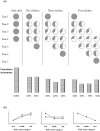Middleborns disadvantaged? Testing birth-order effects on fitness in pre-industrial Finns
- PMID: 19492096
- PMCID: PMC2683935
- DOI: 10.1371/journal.pone.0005680
Middleborns disadvantaged? Testing birth-order effects on fitness in pre-industrial Finns
Abstract
Parental investment is a limited resource for which offspring compete in order to increase their own survival and reproductive success. However, parents might be selected to influence the outcome of sibling competition through differential investment. While evidence for this is widespread in egg-laying species, whether or not this may also be the case in viviparous species is more difficult to determine. We use pre-industrial Finns as our model system and an equal investment model as our null hypothesis, which predicts that (all else being equal) middleborns should be disadvantaged through competition. We found no overall evidence to suggest that middleborns in a family are disadvantaged in terms of their survival, age at first reproduction or lifetime reproductive success. However, when considering birth-order only among same-sexed siblings, first-, middle- and lastborn sons significantly differed in the number of offspring they were able to rear to adulthood, although there was no similar effect among females. Middleborn sons appeared to produce significantly less offspring than first- or lastborn sons, but they did not significantly differ from lastborn sons in the number of offspring reared to adulthood. Our results thus show that taking sex differences into account is important when modelling birth-order effects. We found clear evidence of firstborn sons being advantaged over other sons in the family, and over firstborn daughters. Therefore, our results suggest that parents invest differentially in their offspring in order to both preferentially favour particular offspring or reduce offspring inequalities arising from sibling competition.
Conflict of interest statement
Figures




Similar articles
-
Persistent sex-by-environment effects on offspring fitness and sex-ratio adjustment in a wild bird population.J Anim Ecol. 2015 Mar;84(2):473-86. doi: 10.1111/1365-2656.12294. Epub 2014 Oct 20. J Anim Ecol. 2015. PMID: 25266087 Free PMC article.
-
A trade-off between having many sons and shorter maternal post-reproductive survival in pre-industrial Finland.Biol Lett. 2013 Feb 27;9(2):20130034. doi: 10.1098/rsbl.2013.0034. Print 2013 Apr 23. Biol Lett. 2013. PMID: 23445948 Free PMC article.
-
Producing sons reduces lifetime reproductive success of subsequent offspring in pre-industrial Finns.Proc Biol Sci. 2007 Dec 7;274(1628):2981-8. doi: 10.1098/rspb.2007.1051. Proc Biol Sci. 2007. PMID: 17895226 Free PMC article.
-
Female competition and its evolutionary consequences in mammals.Biol Rev Camb Philos Soc. 2011 May;86(2):341-66. doi: 10.1111/j.1469-185X.2010.00149.x. Biol Rev Camb Philos Soc. 2011. PMID: 20636474 Review.
-
Homosexuality, birth order, and evolution: toward an equilibrium reproductive economics of homosexuality.Arch Sex Behav. 2000 Feb;29(1):1-34. doi: 10.1023/a:1001836320541. Arch Sex Behav. 2000. PMID: 10763427 Review.
Cited by
-
The effects of resource availability and the demographic transition on the genetic correlation between number of children and grandchildren in humans.Heredity (Edinb). 2017 Feb;118(2):186-192. doi: 10.1038/hdy.2016.81. Epub 2016 Sep 14. Heredity (Edinb). 2017. PMID: 27624115 Free PMC article.
-
Culled males, infant mortality and reproductive success in a pre-industrial Finnish population.Proc Biol Sci. 2015 Jan 22;282(1799):20140835. doi: 10.1098/rspb.2014.0835. Proc Biol Sci. 2015. PMID: 25621334 Free PMC article.
-
Kin and birth order effects on male child mortality: three East Asian populations, 1716-1945.Evol Hum Behav. 2017 Mar;38(2):208-216. doi: 10.1016/j.evolhumbehav.2016.10.001. Evol Hum Behav. 2017. PMID: 28781514 Free PMC article.
-
Fitness Consequences of Advanced Ancestral Age over Three Generations in Humans.PLoS One. 2015 Jun 1;10(6):e0128197. doi: 10.1371/journal.pone.0128197. eCollection 2015. PLoS One. 2015. PMID: 26030274 Free PMC article.
-
Early-life reproduction is associated with increased mortality risk but enhanced lifetime fitness in pre-industrial humans.Proc Biol Sci. 2015 Apr 7;282(1804):20143053. doi: 10.1098/rspb.2014.3053. Proc Biol Sci. 2015. PMID: 25740893 Free PMC article.
References
-
- Pavard S, Gagnon A, Desjardins B, Heyer E. Mother's death and child survival: the case of early Quebec. Journal of Biosocial Science. 2005;37:209–227. - PubMed
-
- Voland E. Differential Infant and Child Mortality in Evolutionary Perspective: Data from Late 17th to 19th Century Ostfriesland (Germany). In: Betzig LL, Borgerhoff Mulder M, Turke PW, editors. Human reproductive: A Darwinian Perspective. Cambridge: Cambridge University Press; 1987. pp. 253–261.
-
- Lindström J. Early development and fitness in birds and mammals. Trends in Ecology & Evolution. 1999;14:343–348. - PubMed
-
- Metcalfe NB, Monaghan P. Compensation for a bad start: grow now, pay later? Trends in Ecology & Evolution. 2001;16:254–260. - PubMed
-
- Lummaa V. Early developmental conditions and reproductive success in humans: downstream effects of prenatal famine, birthweight, and timing of birth. American Journal of Human Biology. 2003;15:370–379. - PubMed

